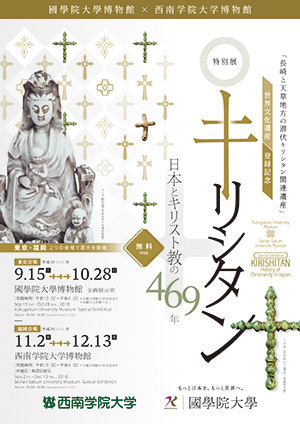We have English explanation part in this exhibition.
For years on the Japanese archipelago, the native animistic religion of Shinto and foreign ones such as Buddhism loosely co-existed and blended together while at times asserting their independence. In 1549, the creator God religion of Christianity arrived in this context. However, with Hideyoshi Toyotomi issuing the first order banishing priests in 1587, Christianity gradually it found itself being further and further restricted. Amidst developments such as the Edo shogunate’s prohibition of Christianity and the Shimabara-Amakusa Rebellion, Japanese Christians were forced to choose whether to maintain their faith in hiding or renounce it. Even after the late nineteenth century Meiji Restoration, some time would pass until Christianity could again be publicly propagated. This exhibition traces the path by which Christianity has tried to lay its roots in Japan, a country where cultures from overseas have been adapted and recast throughout history. Therein we can also find a process of trial and error of those on the receiving side of this religion.
This special exhibition is being jointly held based on a research cooperation agreement between Seinan Gakuin University Museum and Kokugakuin University Museum to mark “Hidden Christian Sites in the Nagasaki Region” acquiring World Heritage status.
*Flyer
Outline
| Term | Sep. 15, 2018 (Sat) - Oct. 28, (Sun) |
|---|---|
| Place | Kokugakuin University Museum, Special Exhibition Space |
| Hours | 10:00 – 18:00 (Last admission 17:30) |
| Closed | Nothing |
| Admission Fee | Free |
| Access | Accessible on foot or by bus, 10-15 minutes from Shibuya, Omote-sandō, or Ebisu Station. Directions to Kokugakuin University Museum |










